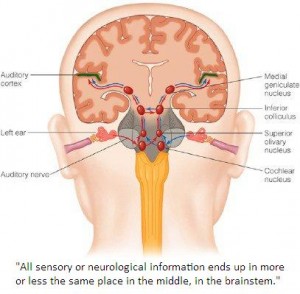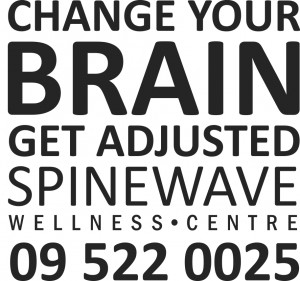“My doctor told me that things would settle down eventually. They did not.”
Previously I had written on dizziness as it relates to eye reflexes and blood pressure. This case will briefly highlight the difference between central vertigo and peripheral vertigo.

Peripheral vertigo is the most common go-to set of diagnoses when someone starts spinning: Meniere’s Disease, otitis media, labrynthitis, benign paroxysmal positional vertigo, viral infection or maybe acoustic neuroma. Peripheral refers to the inner ear region (on the periphery of the head).
Central vertigo would probably be the most likely cause of vertigo for the average person, yet, ironically, the most commonly overlooked. Central refers to neurological disruption in the centre line: brain, brainstem and spine. These 3 things are the functional units which come under the most strain on a day to day basis because of the way we stress and hold our posture. Balance and equilibrium is perceived at the levels of cerebellum and brainstem and they can receive “snowy TV” disturbance from both ends – the brain and eyes above, or spine and body below.
Central vertigo can also cover the third area of vertigo, which relates to systemic problems like blood pressure, blood sugar levels, heart conditions, or psychiatric issues.
Within the inner ear there are various bits and pieces that keep us on the level: Cochlea, semicircular canals and otolithic organs. The cochlea interprets sounds while the canals and otolithic organs are responsible for balance and awareness of position. The otolithic organs detect how fast or slow you’re moving in the vertical and horizontal planes, while the semicircular canals detect angular acceleration with the fluid that moves inside them. In a nanosecond, your brain can work out the angular acceleration of your head and where you are in the world with equations like this, which used to take me hours in engineering school. The brain’s depth of instantaneous computational powers is truly amazing.
What is also truly amazing is the functional design of the semicircular canals that report this information back to the brain in order for these calculations to be performed. There are 3 canals, almost precisely perpendicular to each other in each plane (x, y and z), and each canal detects angular acceleration in its plane. The wisdom of the body didn’t create these haphazardly and place them at random angles, hoping for the best so you don’t fall over. As with most things in nature, there was intent in creation.
We know what the semicircular canals looks like, but to truly recognise the perfection of the design, take a bird’s eye view of both sides of the head – both sets of canals – and you’ll note that each canal works in harmony with its partner in the opposite ear. The upper left canal coordinates with the bottom right canal. They are functional pairs!
(Bossenger, 2006)
All sensory or neurological information ends up in more or less the same place in the middle, in the brainstem, which is why with vertigo people may feel nauseus. The neurology of the upper spine is a specialty, so it’s easy to get confused as to where the problem might be coming from. Is it coming from the periphery, or the centre? ?
 It was a normal working week. The alarm went off at 5:50 am as usual. I got out of bed, then it hit me – severe dizziness. The room was spinning. I staggered to the bathroom because I had an overwhelming sensation to throw up.
It was a normal working week. The alarm went off at 5:50 am as usual. I got out of bed, then it hit me – severe dizziness. The room was spinning. I staggered to the bathroom because I had an overwhelming sensation to throw up.
I was a mess. I staggered back to the bedroom thinking that lying down on the bed would ease the dizziness. I was so wrong. It became more intense. I forced myself to sit up.
Who can I ring for help? My diary was upstairs, so too was my cell phone. I knew I could not manage the stairs. I could not ring my neighbour, friends or family for assistance. I rang 111 and asked for an ambulance.
I was taken to the emergency department of the Auckland City Hospital. A few test were done along with a couple of conversations with the doctors. A stroke was ruled out.
I was sent home after 6 hours. The hospital sent through their notes to my doctor. I went to my own doctor the next day. An inner ear imbalance was the general conclusion. I was given a course of drugs to dry up any excess moisture and the dizziness should cease.
While I could go back to work, I managed the dizziness as best I could. I had to make sure I did not get out of bed in a hurry, no jerky movements, walk calmly, hold on to chairs or tables if stationary and above all try not to drop anything because bending down to pick anything up would send me into a spin. My doctor told me that things would settle down eventually. They did not.
My daughter suggested that I go to see Neil. I had never been to a Chiropractor. I had all to gain and absolutely nothing to lose. Neil worked with me through the ensuing weeks and I am forever grateful to him. I am well again thanks to him.
I go back to Spinewave from time to time to have a wellness check.
Carolyn
© Dr Neil Bossenger 2011



